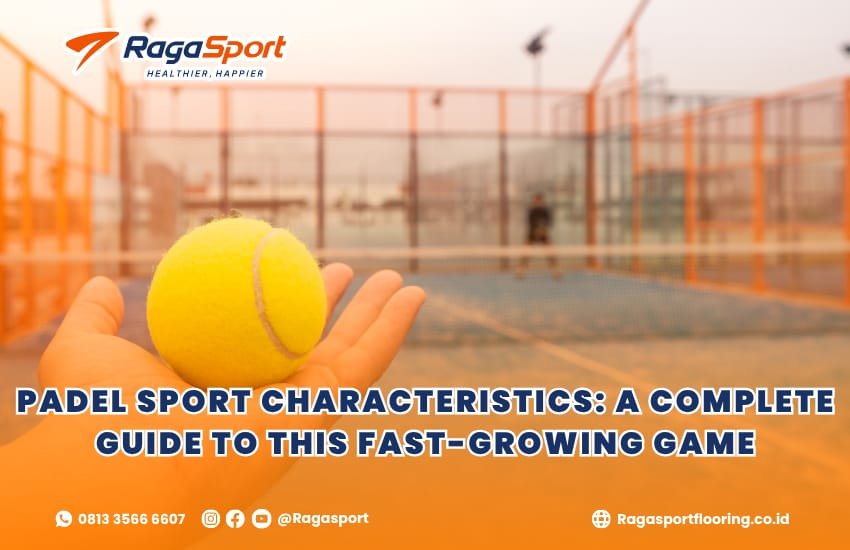Padel sport characteristics define what makes this fast-growing racket sport so unique and appealing to players worldwide. From its compact court structure and glass walls to its strategic gameplay and social nature, padel continues to gain traction as one of the most dynamic sports of the modern era.
Table of Contents
1. Court Dimensions and Structure
One of the most defining padel sport characteristics is its unique court design. A standard padel court measures 10 meters wide by 20 meters long, making it significantly smaller than a tennis court. Glass walls and metal fencing surround the court, influencing gameplay and strategy.
2. Scoring System
Another important aspect of padel sport characteristics is the familiar scoring system borrowed from tennis. Points are scored as 15, 30, 40, and game—keeping the game accessible to those who already know tennis, while still being intuitive for beginners.
3. Equipment Used
Racket
Padel rackets, also known as paddles, are solid with no strings. They are perforated with holes and made of composite materials like fiberglass or carbon fiber. The typical length is about 45 cm, and the racket is shorter and more compact than a tennis racquet. The absence of strings changes how spin and power are generated, requiring more wrist action and control.
Balls
Padel balls are similar in size to tennis balls but slightly less pressurized, which results in lower bounce. This feature contributes to the strategic pace and rhythm of the game.
4. Number of Players

Padel is mostly played in doubles—two players per side. While singles play is possible on smaller courts, the doubles format is standard and encourages a social, collaborative environment. This team aspect makes padel especially popular among casual players and families.
5. Serve Rules and Techniques
Unlike tennis, where players serve overhead, padel serves are underhand. The serve must bounce behind the service line and be struck below waist height. The ball must then land diagonally across the net in the opposite service box.
This method of serving reduces the dominance of powerful servers, levels the playing field, and encourages longer rallies and skill-based play.
6. Game Strategy and Play Style
Padel is a highly strategic game. Due to the walls and smaller court size, brute strength often gives way to tactical finesse. Players must learn to position themselves well, anticipate rebounds off the glass, and work effectively with their partner.
Some typical strategies include:
- Lob shots to push opponents back.
- Volleys and smashes near the net to control the point.
- Rebound anticipation, especially after a defensive shot hits the glass.
The communication between partners is crucial, and well-coordinated teams often outperform technically superior players.
7. Physical and Mental Demands
The physical and mental padel sport characteristics make it an engaging yet accessible sport for all ages. It requires agility, good footwork, and quick decision-making, while still being low-impact and beginner-friendly.
8. Accessibility and Global Reach

One of the most appealing characteristics of padel is how accessible it is. The underhand serve, smaller court, and doubles format allow beginners to start playing and enjoying the game within a short learning curve.
In countries like Spain, Sweden, Italy, and Argentina, padel has become a mainstream sport. Clubs and facilities are rapidly growing in countries like the UK, USA, UAE, and Indonesia. The International Padel Federation (FIP) is also working to make it an Olympic sport.
9. Social and Community Aspect
Padel is not just a sport—it’s a social experience. Most games are doubles, and clubs often create tournaments and events that foster community engagement. The sport’s welcoming atmosphere is one of the main reasons behind its explosive growth. It serves as both a competitive outlet and a recreational pastime.
10. Safety and Injury Risk
Padel is generally considered safe with a low risk of serious injury. The smaller court and slower ball speed (compared to tennis) reduce the chance of overexertion. However, like any sport, proper warm-up and good technique are necessary to avoid sprains or strains.
Conclusion
The characteristics of padel sport make it a unique blend of strategy, social interaction, and fun. Its fast-paced yet accessible gameplay attracts players from all backgrounds. From its signature glass walls to its inclusive community, padel continues to expand globally as one of the most dynamic and enjoyable racket sports available today.
If you’re inspired to join the wave, there’s never been a better time to start.
Build Your Own Padel Court Today

Thinking of building your own padel court or starting a padel facility? We can help you bring that vision to life. Visit ragasport.com/padel-court-construction-services for professional court construction services.
Need direct assistance? Contact us via WhatsApp for consultation and pricing information.

